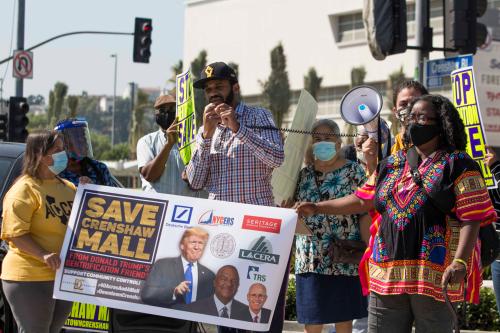In 2021, despite continued struggles during the COVID-19 pandemic, the number of Black-owned businesses grew by 14.3% from the year prior. This growth is a significant achievement in a landscape where Black individuals still own the lowest share of employer firms (firms with more than one employee) compared to every other racial group. The following year, Black median wealth grew, along with a 30% increase in employer firm revenue.
In the face of this progress, a litany of lawsuits combatting programs that intentionally fund Black-owned businesses is moving through the courts, emboldened by two watershed Supreme Court cases that ended affirmative action in higher education last year. The legal backlash against DEI (diversity, equity, and inclusion) initiatives has been swift, leaving a chilling effect across government, nonprofit, and private investment programs. For these investors, the question lingers: Is it still legal to invest in Black-owned businesses?
Responses from experts seem to be “yes,” but with some alternative strategies. Governments, philanthropists, banks, and businesses must use funding methods that pass legal scrutiny—and fortunately, many already exist. This report explains how tools such as special purpose credit programs, community development financial institutions, and placed-based investment—along with innovative funding models such as community ownership and crowdfunding—are all legal strategies funders can use to invest in Black businesses today.
Legal attacks on DEI lending and race-conscious policy have escalated
In their ongoing attack on race-conscious practices, anti-DEI activists have filed more than 50 lawsuits against government, private, and philanthropic organizations since last summer, according to legal expert Alphonso David. The arguments against funding Black-owned businesses in these cases have been empowered by the precedent set by last year’s Supreme Court rulings in Students for Fair Admissions v. President and Fellows of Harvard College and Students for Fair Admissions v. University of North Carolina, which ended the use of race-conscious policy (often referred to as “affirmative action”) in college and university admissions. The main argument of the plaintiff, Students for Fair Admissions, was that accounting for race in a college application—even with the aim of narrowing opportunity gaps—violates the Equal Protection Clause of the Fourteenth Amendment. Three recent cases used similar legal arguments to take down programs that support Black entrepreneurs.
This past March, in Nuziard v. Minority Business Development Agency (MBDA), a federal court in Texas ruled that the MBDA cannot consider race or ethnicity when administering support to businesses because it violates the Equal Protection Clause. This ruling comes despite the persistent and stark disparities in business ownership along racial lines, as well as documented gaps in funding opportunities due to structural racism. In a recent Gallup poll, 17% of Black business owners reported unfair treatment when trying to acquire loans, compared to 15.6% of Latino or Hispanic business owners and 2.6% of white businesses owners. Additionally, 72.2% of Black entrepreneurs reported that acquiring financing was “difficult or very difficult,” compared to 61.3% of Latino or Hispanic entrepreneurs and 39.5% of white entrepreneurs.
In another case from September 2023, a Tennessee court determined in Ultima Services Corp. v. U.S. Department of Agriculture that the Small Business Administration’s (SBA) 8(a) program was discriminatory against white people, again using precedent from the Supreme Court rulings on affirmative action. Approximately 4,800 socially and economically disadvantaged small businesses receive training and technical assistance from the 8(a) program; the program plays a part in narrowing the Black employer firm gap by supporting already established businesses (those operating for two or more years). The court deemed that SBA investments in businesses based on the owner’s race are illegal, but the agency could continue investing in disadvantaged business owners. To allow the program to continue, the SBA created a new requirement for potential grantees of color: submitting written proof that race was a disadvantage to owning a business. Importantly, being Black or any other minority is not a hinderance to entrepreneurship—the actual hinderance is often systematic barriers to funding, including the over-complicated and demeaning processes created from this case.
Finally, this past June, the U.S. Court of Appeals for the Eleventh Circuit decided in American Alliance for Equal Rights v. Fearless Fund Management to halt a venture capital grant program run by Fearless Fund, because the grant application considered the entrepreneurs’ race and gender. The plaintiffs of the case are led by the same anti-DEI activists who brought forward the cases against the University of North Carolina at Chapel Hill and Harvard. Their organization argues that Civil Rights Act of 1866, which prohibits racial discrimination in contracts, also prohibits grant program applications that favor Black women because it is discriminatory against white people. Fearless Fund defended their firm’s mission to close the venture capital funding gap for Black women, who in the boom of venture capital funding for Black-owned business in 2021 received 0.034% of total funding. Additionally, investing in Black women business owners makes financial sense. Despite Black women making up just 1.1% of employer business owners in 2021, their businesses had the highest annual growth rate: 20.2%, compared 11.5% for Black men and 3.1% for non-Black women. Closing this gendered funding gap is another crucial part of closing racial wealth gaps for entrepreneurs who have largely been left out of the venture capital boom.
Investing in Black business owners does not harm white people
In 2021, white business owners made up 82% of employer business owners, and had the highest average revenue, number of employees, and payroll amount of any other racial or ethnic group. Yet despite this, the litigation against Black-owned business investment largely hinges on the argument that white business owners are being discriminated against.
However, investing in Black people does not undercut financial gains for white people. As shown in our latest piece on the racial wealth gap, wealth increases for Black Americans and other minority groups did not hinder overall wealth increases for white Americans. From 2019 to 2022, median white wealth outgrew median Black wealth, even with a lower growth rate. In this period, median white wealth grew at a rate of 30.7%, compared to 60.5% for median Black wealth—yet the wealth gap widened. That’s because white wealth compounded on a larger total over a longer stretch of time, due to centuries of enslaving Black people and benefiting from policies that limited Black access to capital, their means of growing capital, and the industries or places in which they were allowed to participate.
Programs seeking to increase wealth opportunities for Black people are not harming white wallets. Investors should continue to increase funding for Black-owned businesses, as it is a critical component in narrowing the racial wealth gap.
Innovative strategies for investing in Black-owned businesses
Despite the court cases outlined earlier in this report, investing in Black-owned businesses is still very much legal. However, strategies that explicitly use race as a funding criterion are increasingly at risk. The flurry of litigation—with new cases coming against private and public institutions every month—is not only meant to change legal precedent, but also instill a chilling effect that scares off potential investors. But there are many other means to the same end. Below is a list of fully legal tactics already in use around the country, which investors can use individually or in tandem.
Special purpose credit programs (SPCPs) are targeted lending programs for economically and socially disadvantaged groups. SPCPs are legally allowed to offer business loans based on race because the 1974 Equal Credit Opportunity Act allows race to be used in designating small business loans for the specific purpose of meeting data-backed, social needs such as closing the racial wealth gap. The legality of these programs is well established, with both the Consumer Financial Protection Bureau and Department of Housing and Urban Development coming out with guidance in support of SPCPs in recent years. Banks, nonprofits, and public and private investors can establish these programs to narrow racial gaps in business and home ownership. For example, U.S. Bank implemented a SPCP to offer loans for businesses owned by women, minorities, and veterans. These loans have a limit of $2.5 million, have lower credit score requirements, and offer more flexible lending options than traditional loans. The National Fair Housing Alliance’s toolkit and the American Bankers Association’s regulation guidance are helpful resources for interested investors.
Community development financial institutions (CDFIs) are organizations funded and certified by the U.S. Treasury Department to distribute dollars for affordable microloans in distressed communities where traditional banking has failed. In practice, CDFIs can funnel not only Treasury dollars but also state, local, and philanthropic funding to local businesses. CDFIs are another way to increase capital flow to Black business owners and entrepreneurs because they are often situated in majority-minority communities that are ripe with historically underserved entrepreneurs. For example, in a previous report on neighborhood investment in Detroit, we found that local CDFI Invest Detroit played a crucial role in funding Black-owned businesses along a central commercial corridor without pushing out residents. CDFIs also have a proven track record, approving Black business owners’ applications at twice the rate of large banks. Different actors can play various roles in this process: Local community developers and organizations can form CDFIs, while state and city governments and philanthropists can contribute to CDFI funds.
Place-based funding is an investment strategy in which funders target specific neighborhoods, cities, or counties due to a compelling local economic opportunity. This funding method is legal and commonly used by cities and developers to strategically invest in certain areas. The legacy of segregation connecting race to place still lingers in many metro areas, and often this means that gaps remain in the availability of financial resources and opportunities. For example, consumers undervalue businesses in ZIP codes with higher concentrations of Black residents, even when those businesses are highly rated; this causes these businesses to lose out on $3.9 billion each year due to their vicinity to Black communities. However, this connection between race and place can also be seen as an asset for funders to combat disparities. Place-based funding in majority-Black areas would help counteract lost investment and require banks, nonprofits, governments, and private investors to more intentionally focus their dollars in these areas, which are full of Black entrepreneurs and community leaders.
Community-ownership models are a funding strategy that empowers community members to have an equity stake in businesses and investment properties, making way for more self-reliant efforts to build capital. This model uses small investments from a large group of local people, rather than exclusively acquiring funds from banks or other lending institutions. The benefit of this model is that it organizes local actors and community members to collectively buy into a local business, with both financial and personal benefits. Garnering that local support supplies business owners with upfront capital and builds local enthusiasm, likely ensuring that local investors, their families, and their neighbors will be more likely to frequent the business. And when that business thrives, those local investors gain wealth as well. For example, Detroit’s Grandmont Rosedale Development Corporation is considering offering 49% of the equity interest to local residents for future businesses along a main commercial strip in their neighborhood, which could increase communal wealth across the 94% Black population. Community-owned businesses also help combat displacement that can occur following development. For example, Inclusive Action for the City in Los Angeles and the Allapattah Collaborative in Miami are both nonprofits that facilitate community ownership by acquiring commercial properties in gentrifying majority-minority neighborhoods, and then offering those properties to local businesses using the funding model.
Crowdfunding is a viable and growing business investment method that similarly allows for smaller investments from community members, but can source from people anywhere. Crowdfunding does not always require future profit sharing with those who invest, but can instead facilitate donation-type investments or reward investors with benefits such as reduced costs for that business’s services. Typically done through platforms such as GoFundMe, Kickstarter, and Patreon, crowdfunding is especially popular for women-owned businesses, according to a recent report from the Securities and Exchange Commission. Crowdfunding is useful across industries, business sizes, and business ages. Black business owners are increasingly using this funding model, making up 10.4% of crowdfunded entrepreneurs in 2022. This model also expands an entrepreneur’s monetary support outside of their direct social network, which the racial wealth gap often hinders, as less funds are available in the average Black support network than for other racial groups. For example, Black startup owners receive nearly half the financial support from friends, family, and financial institutions as white and Asian American entrepreneurs. However, there are regulations on crowdfunding that limit which platforms business owners can use, how much a funder can give, and how often they can give.
The backlash to Black business success is part of a historic pattern—but so is progress
The attack on affirmative action is not new; it is part of a pattern of backlash against progressive racial policies repeated throughout our history. Following civil rights movement wins, the silent majority formed and built a platform to slow and reverse desegregation. The mere existence of Black wealth-building in the Black Wall Streets of Tulsa, Okla. and Durham, N.C. in the early 1900s was met with outrage and violence. Even after President Richard Nixon supported an affirmative action plan in Philadelphia in 1969 to increase the Black employment, white contractors sued his administration. The backlash against DEI, critical race theory, and general race-conscious (or “woke”) culture follows these patterns of history and is carried into courts by the current surge of lawsuits. But just as in the past, progress will continue as well.
The toolbox for investors is still full of strategies to fund Black-owned businesses and continue the growth seen in 2021. To do so is not just financially advantageous but necessary, as the racial gap between business ownership and community wealth remains vast. In the face of anti-DEI litigation, funders and organizations do not need to run from their commitments to equitable investments, but rather alter their methods and remain on course.





